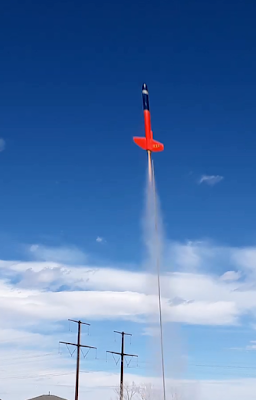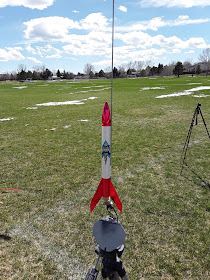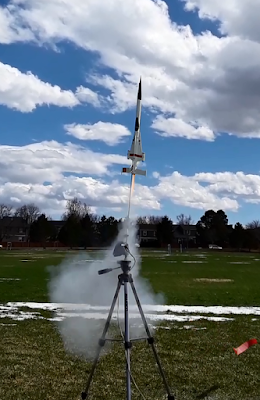Early Sunday afternoon, I found an email from fellow
Castle Rock area rocketeer, James Gazur, stating that local wind and weather
conditions were favorable for a launch.
How about it?
Having not flown any model rockets for nearly six months,
I was totally ready for a flying fix.I had models, launcher, and range box packed, and made the drive to the designated field in less than half an hour’s time!
The chosen field for this launch was Founders Park on the East side of Castle Rock. I had discovered this location a few months ago, finding it extensive enough to be a solid B-engine launch site.
On arriving at the park, we found it to be about half covered with snow from a couple of recent storms. Undaunted, we set up at one end of the field to assure enough recovery area with the five to seven mph breezes blowing at the time.
I started things off with the 42nd launch of the old Hornet. Perfect launch and nearby recovery on an A3-4T motor and eight inch parachute.
Jim’s first flight of the afternoon went to a Semroc Heli-rocter on a ½A3-2T motor. The model boosted nicely and deployed its rotors perfectly at ejection. The launch video taken of the flight shows an approximate duration of 27 seconds. Not bad at all for a 1/2A heli.
Next up was my Estes Lynx for its overall 8th flight mission. The model boosted straight and high on an A10-3T motor and recovered via ten inch parachute to land very near the launch area. It was discovered that three of the parachute shroud lines had been burned through at ejection, but all the lines were wound together closer to the canopy, so the parachute still operated normally.
A pair of 7th grade boys had stopped by to witness some of the launching activities, and I ended up letting each of them push the launch button to send off my first two models. Their presence was the first opportunity I had to hand out a couple of my new model rocket resource/info sheets.
One of the lads said that being an astronaut was one of his career options.
Jim exhorted him to do well in school, stick with it, and place extra emphasis on doing well in math.
Perhaps this encounter could lead to another young person’s entry into model rocketry, as well as a future career in aerospace.
The next bird to be launched was Jim’s FlatCat glider modified for RC control. This is a developmental version utilizing rudder control only. The model boosted nicely on an A3-2T motor (Jim still has a small supply of these gems from days of yore), and transitioned into a turning glide. The inherent turn was a bit more than what the controls could overcome, but Jim considered it a successful test flight, nonetheless.
Next up was the maiden voyage of my recently built Alpha VI. This launch is intended to be the model’s one and only flight, after which it will be retired and mounted in a display box.
The Alpha turned in a picture perfect flight on an A8-3 motor – straight boost, full parachute deployment, and even a soft landing a mere twenty feet away from my range box!
Jim made the comment that it was a similar such flight of an Alpha model rocket that he witnessed many years ago that sparked his interest in the hobby and led directly to his lifelong career in aerospace!
Jim soon had another experimental RC glider ready to launch – this time a modified Renger Sky Slash. He is definitely going old school with some tried and true glider designs. The bird also uses single channel, rudder-only control.
The glider boosted nicely with A10-0T power and transitioned into a glide after motor ejection. Jim was able to successfully perform some control over the glide. Another successful development test flight!
By this time, I had a scratch-built Satellite Interceptor on the pad and ready to launch.
On a B6-4 motor , the model boosted in a very straight and high trajectory. The 12” parachute deployed nicely and the model descended smoothly.
Unfortunately, the prevailing breeze carried the model just outside of the park perimeter and into the parking lot, where it landed on the hard asphalt surface. The SI sustained a small amount of damage - a loose dorsal fin, and two broken dowel fin antennae.
The final flight of the day went to Jim’s Vortico from Rocketarium. This unique little model turned in a great flight on a Quest C12-4. The black smoke trail and rapid spinning of the model made for a very fun performance.
Quote of the Day:
One of the young men who had stopped by to watch the launchings sported a head of long wavy hair. As I was setting up my wind direction indicator streamer next to a launch pad, he commented:
“My hair would work good for that!”






















No comments:
Post a Comment